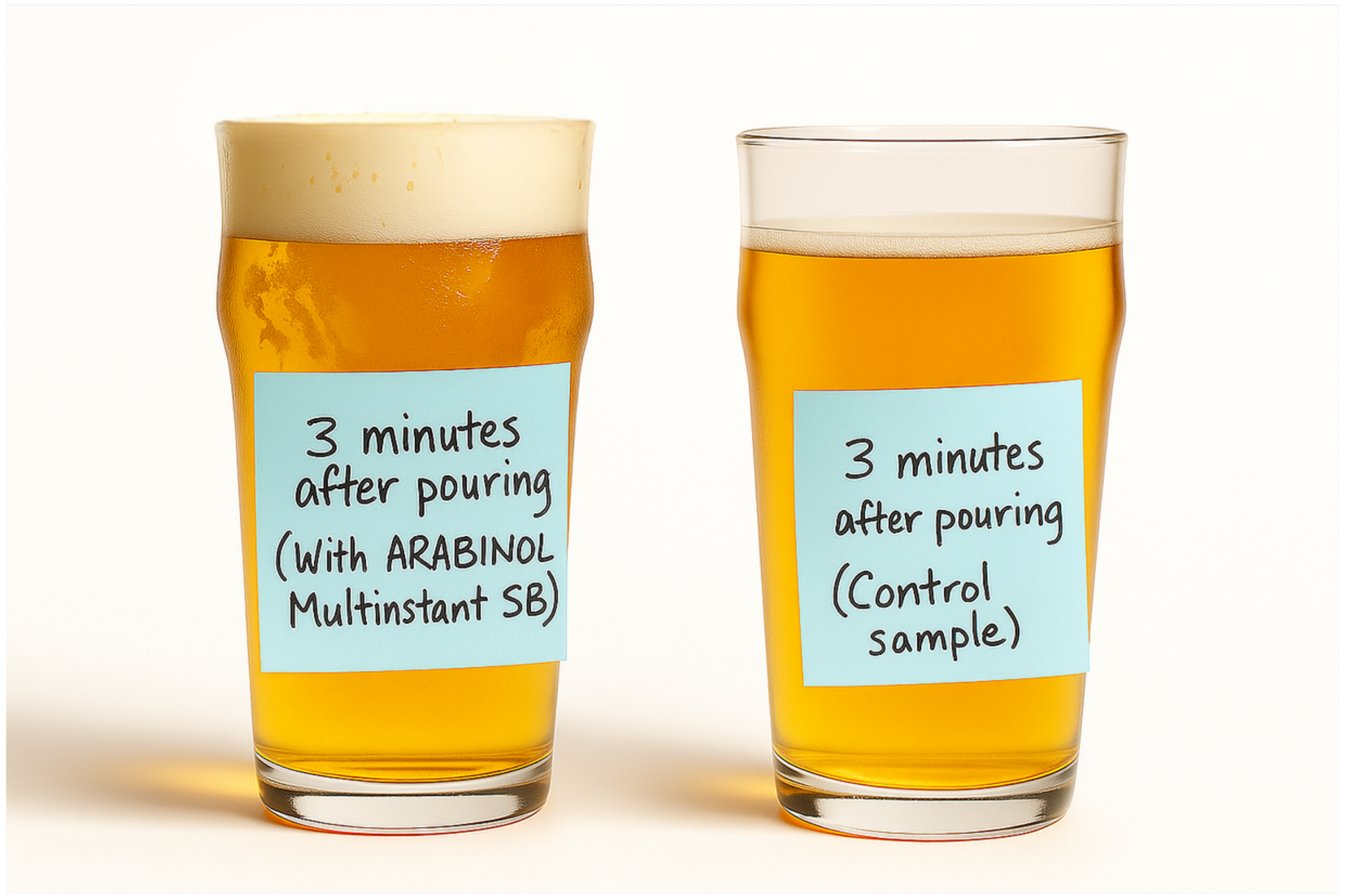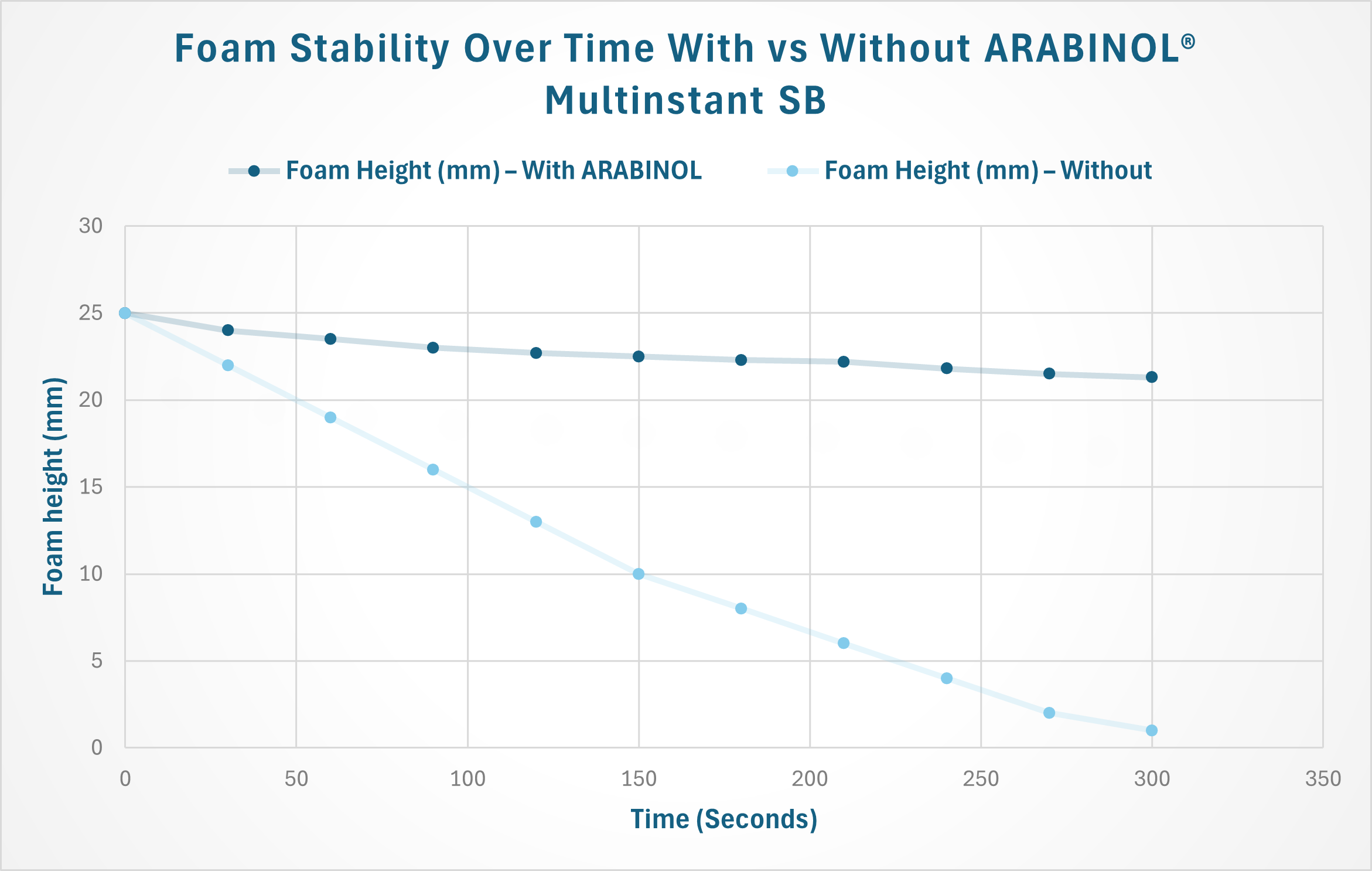ARABINOL® Multinstant SB is a highly refined, micro-granulated gum arabic for improving head retention. Derived from Acacia senegal, its instantly soluble polysaccharide matrix enhances mouthfeel and body and head retention, key attributes for beer quality and consumer appeal. Five times more concentrated than traditional liquid gum arabic.
Key Technical Benefits and Mechanisms
Bench-Top Validation: ARABINOL® Multinstant SB in a European Lager
To visually demonstrate the functional impact of ARABINOL® Multinstant SB on foam retention, a simple bench-top trial was conducted using a commercial European-style lager (330 mL, 4.8% ABV). Two samples were prepared:
Left glass: Control (no additive)
Right glass: Treated with ARABINOL® Multinstant SB at 20 mL/hL
The same base beer was poured simultaneously into both glasses, and photos were taken at 3 key time points to document foam performance over time:
Figure a) Immediately after pouringFigure b) 1 minute after pouringFigure c) 3 minutes after pouringThis bench-top trial illustrates the clear functional benefit of ARABINOL® Multinstant SB in improving foam stability under real brewing conditions. When added at a dosage of 20 mL/hL to a standard European-style lager, the treated sample consistently retained a more stable and lasting foam head compared to the untreated control. The visual difference became increasingly apparent over time, with the control beer showing significant foam collapse after just one minute, while the ARABINOL®-treated beer maintained its structure and sensory appeal. These results support its application in styles where foam quality is essential for consumer perception.
Best Practices: When to Add ARABINOL® Multinstant SB
For optimal results, ARABINOL® Multinstant SB should be dissolved in beer and then added directly to the Bright Beer Tank prior to packaging, seamlessly integrating into your production process without additional steps or equipment.
Early addition (e.g., during fermentation or filtration) is not recommended, as the product may be removed or its effects diminished during clarification or processing. To ensure uniform distribution, the product should be fully dissolved in water and added with proper mixing. Because it is a preservative-free organic polysaccharide, the prepared solution must be used immediately after preparation to avoid microbial growth or degradation.
Foam Stability Over Time With ARABINOL® Multinstant SB vs Without
Below is a comparison of foam stability over time in standard brewing conditions, showing the difference between using ARABINOL® Multinstant SB and not using it.
The data presented in this chart is not extracted from formal control trials using ARABINOL® Multinstant SB. It is based on documented functional properties of gum arabic from academic literature and its known effects on foam retention and mouthfeel in beverage applications.
Targeted Use: Style-Specific Application Guide
Ana Victoria Vasquez de la Peña
ana@neumaker.com.au
11 July 2025
© 2025 neumaker. All rights reserved. This article may be shared/forwarded for personal or educational purposes, provided it remains unaltered and includes proper attribution. Reproduction, distribution, or use in any other form—including but not limited to commercial purposes, republishing, or adaptation—without explicit written permission is strictly prohibited.
References
Dickinson, E. (2003). Hydrocolloids at interfaces and the influence on the properties of dispersed systems. Food Hydrocolloids, 17(1), 25–39. https://doi.org/10.1016/S0268-005X(01)00120-5
Gawel, R., & Godden, P. (2008). Evaluation of the mouthfeel of white wine using descriptive analysis. Australian Journal of Grape and Wine Research, 14(1), 47–54. https://doi.org/10.1111/j.1755-0238.2008.00006.x
Karaaslan, M., & Çelik, S. (2011). Gum arabic emulsions: Microstructure, stability and rheology as affected by concentration and pH. Food Hydrocolloids, 25(5), 1006–1014. https://doi.org/10.1016/j.foodhyd.2010.09.016
Lawless, H. T., & Heymann, H. (2010). Sensory Evaluation of Food: Principles and Practices (2nd ed.). Springer.
McClements, D. J. (2015). Food Emulsions: Principles, Practices, and Techniques (3rd ed.). CRC Press.
Russell, I., & Bamforth, C. W. (2011). Brewing: Science and Practice. Woodhead Publishing.
Svanberg, S. J., & Nylander, J. A. A. (2015). The impact of colloids on foam stability in beer. Journal of the Institute of Brewing, 121(4), 530–537. https://doi.org/10.1002/jib.259
Cheung, I. M. L., & Mehta, B. M. (2015). Polysaccharides in Food Applications. In M. R. Patel (Ed.), Functional and Specialty Beverage Technology (pp. 143–172). CRC Press.









